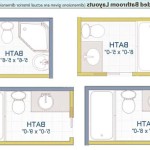What Is the Size of a Bathroom Vanity?
A bathroom vanity is a crucial element of any bathroom, serving as a storage space for toiletries and a foundation for the bathroom sink. Choosing the right size vanity is essential to ensure functionality, aesthetics, and proper flow of the bathroom. The size of a bathroom vanity is measured by its width, depth, and height. These dimensions are crucial factors in determining the suitability of a vanity for a particular bathroom.
Understanding Vanity Dimensions
Bathroom vanities are available in a wide range of sizes, each tailored to suit different bathroom layouts and personal preferences. Understanding the different dimensions of a bathroom vanity is crucial for making an informed decision.
Width refers to the horizontal measurement of the vanity, typically ranging from 24 inches to 72 inches. Smaller vanities are suitable for compact bathrooms, while larger vanities offer ample storage and counter space in spacious bathrooms.
Depth represents the vanity's front-to-back measurement, usually ranging from 18 inches to 22 inches. A deeper vanity allows for more countertop space and storage but can make the bathroom feel smaller.
Height, the vertical measurement of the vanity, often ranges from 30 inches to 36 inches. The standard height for vanities is 32 inches, but smaller or taller variations are available to suit specific needs.
Factors to Consider When Choosing Vanity Size
When choosing the right size bathroom vanity, several factors need to be considered to ensure optimal functionality and aesthetics. These factors include:
1. Bathroom Size
A small bathroom requires a smaller vanity to avoid overcrowding and maintain a sense of spaciousness. Large bathrooms can accommodate larger vanities that provide ample storage and counter space. The vanity size should be proportional to the overall bathroom size, ensuring a balanced and comfortable experience.
2. Sink and Faucet Type
The size of the sink and faucet is directly related to the vanity size. A large vessel sink requires a wider vanity, while a smaller undermount sink can fit on a smaller vanity. The faucet type, such as a widespread or centerset faucet, also impacts the required vanity width and depth.
3. Storage Needs
Consider the amount of storage needed for toiletries, towels, and other bathroom essentials. A vanity with drawers, cabinets, or shelves provides ample storage for organizing bathroom items. Larger vanities offer more storage options, while smaller vanities may require additional storage solutions like a medicine cabinet or wall shelves.
4. Existing Plumbing
Existing plumbing fixtures and drain location can influence the placement and size of the vanity. It's advisable to measure the distance between the drain and the wall to ensure the vanity fits comfortably without requiring significant plumbing adjustments.
5. Desired Style
Bathroom vanities come in various styles, from traditional to contemporary. The desired style influences the overall look and feel of the bathroom. Consider the overall bathroom design and choose a vanity that complements the existing style.
In conclusion, choosing the right size bathroom vanity is crucial for creating a functional and aesthetically pleasing bathroom. By considering bathroom size, sink and faucet type, storage needs, existing plumbing, and desired style, homeowners can select a vanity that meets their specific requirements and enhances their bathroom experience.

What Is The Standard Height Of A Bathroom Vanity Sizes Vessel Sink Cabinets

What Is The Standard Height Of A Bathroom Vanity

What S The Standard Depth Of A Bathroom Vanity

What Is The Standard Bathroom Vanity Height Size Guide

Plan Your Bathroom By The Most Suitable Dimensions Guide Engineering Discoveries Vessel Sink Vanity Floor Plans Washbasin Design

What Is The Standard Bathroom Vanity Height Size Guide

What Is The Standard Height Of A Bathroom Vanity

What Is The Standard Height Of A Bathroom Vanity

What Is The Standard Bathroom Sink Height

Counter Top Sink Bathroom Vessel Vanity Sizes
Related Posts







